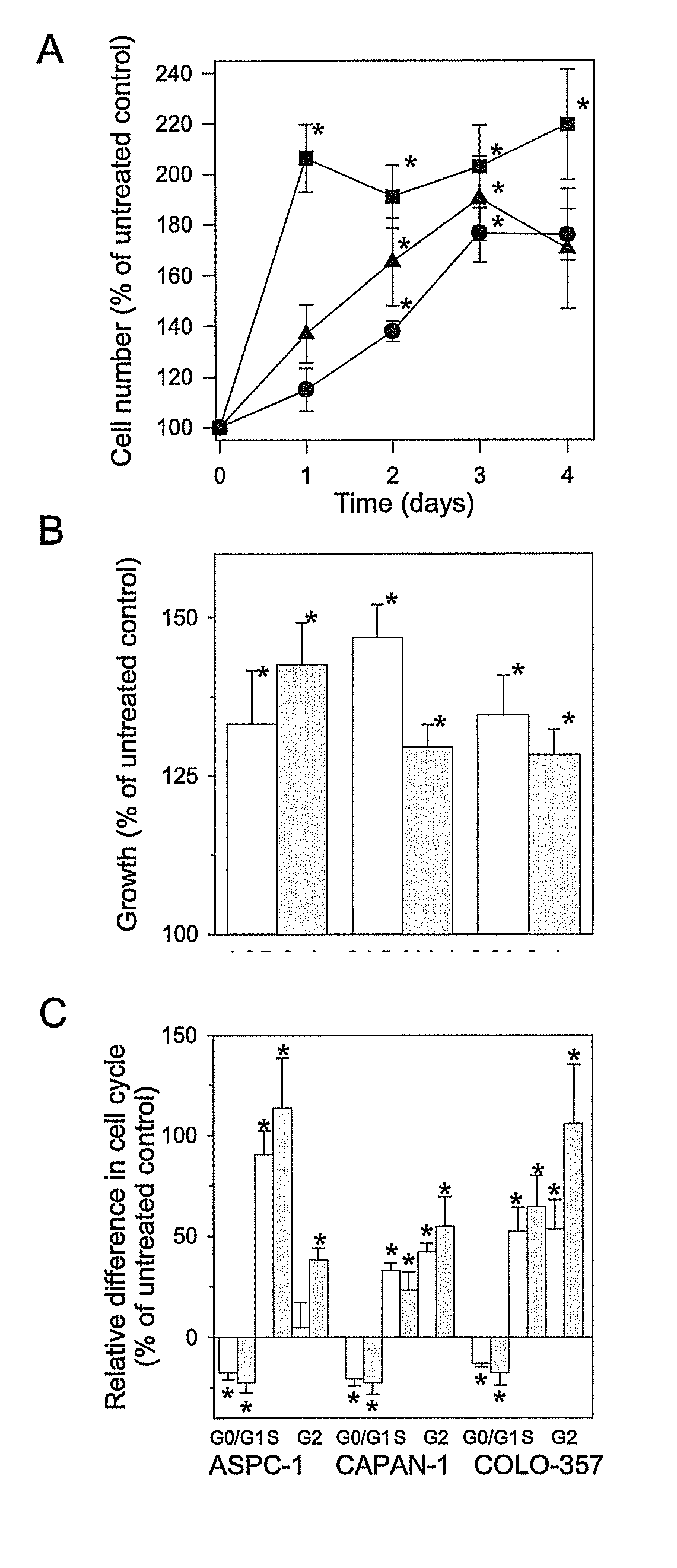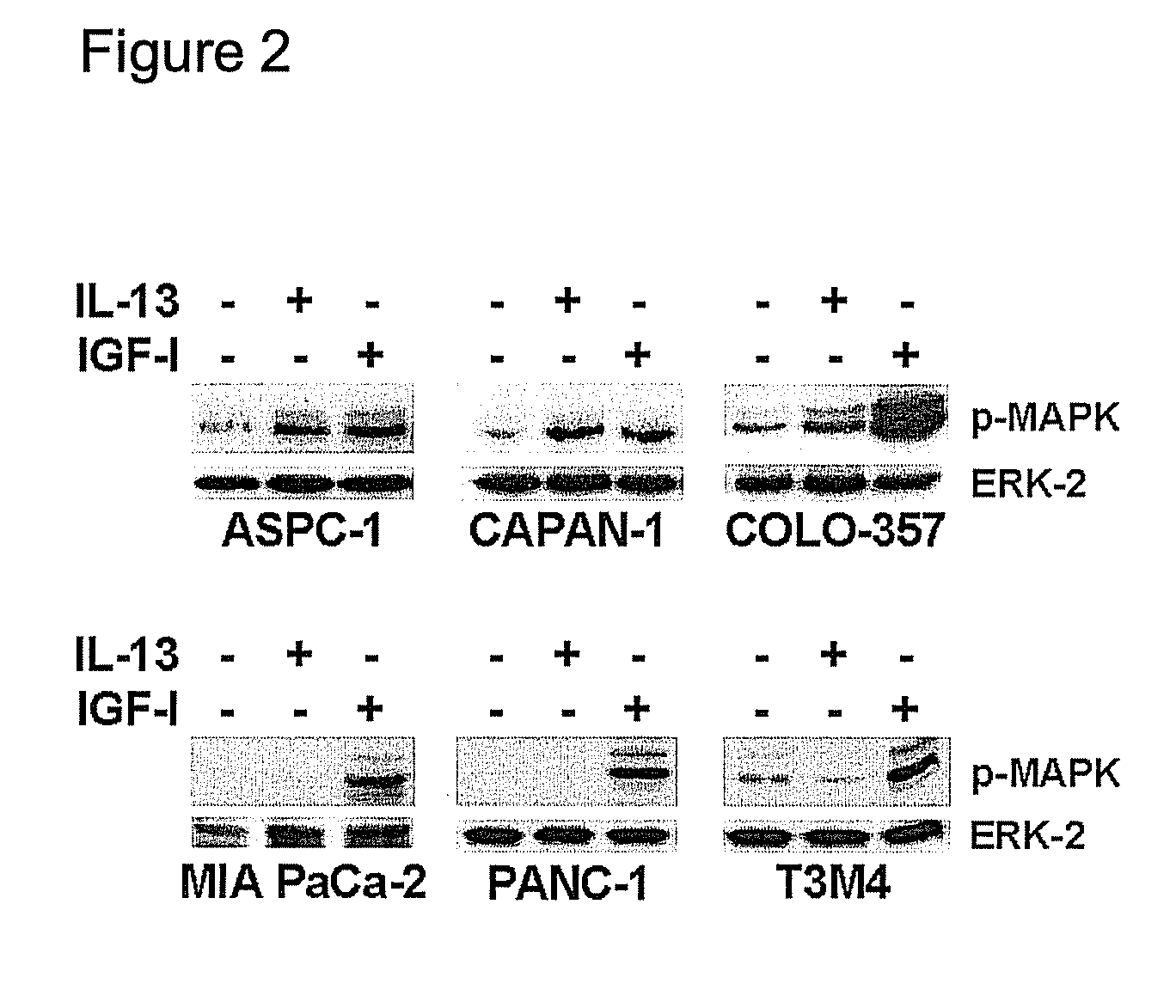Il-4 receptor and il-13 as prognostic markers for colon and pancreas tumors
a tumor and prognostic marker technology, applied in the field of il4 receptor and il13 expression as diagnostic and/or prognostic markers for tumors, can solve the problems of reduced overall survival and/or and achieve the effects of reducing overall survival, high expression, and high incidence of lymph node involvemen
- Summary
- Abstract
- Description
- Claims
- Application Information
AI Technical Summary
Benefits of technology
Problems solved by technology
Method used
Image
Examples
example 1
Materials and methods
Materials
[0045]The following were purchased: IL-13 ELISA kit and mouse monoclonal antibody against IL-13 from BioSource International (Camarillo, Calif.); Dako ABC kit for immunohistochemistry from Dako Denmark (Glostrup, Denmark); carrier-free neutralizing human IL-13 antibody (mouse monoclonal, 32116) and mouse monoclonal antibody against IL-4R from R&D Systems, Inc. (Minneapolis, Minn.); human IL-13, anti-active MAPK (p-ERK, E-4) mouse monoclonal antibody, and human recombinant IGF-I from Sigma Chemical Co. (St. Louis, Mo.); rabbit polyclonal antibodies against IRS-1 and IRS-2 from Upstate Biotechnology Inc. (Lake Placid, N.Y.).
Cell Culture and Growth Assays
[0046]ASPC-1, CAPAN-1, MIA PaCa-2, and PANC-1 human pancreatic cancer cells were purchased from American Type Culture Collection (ATCC, Rockville, Md.). COLO-357 and T3M4 human pancreatic cancer cells were a gift from R. S. Metzgar (Duke University, Durham, N.C.). COLO-357, MIA PaCa-2, and PANC-1 cells wer...
example 2
Effect of IL-13 on Pancreatic Cancer-Cell Proliferation
[0059]IL-13 exerted a dose-dependent increase in the growth in ASPC-1, CAPAN-1, and COLO-357 cells. At a maximally effective concentration of 5 nM, IL-13 increased cell growth by 33% (±2% SEM) and 35% (±2% SEM) in ASPC-1 and COLO-357 cells, respectively, after 48 h. In the most responsive CAPAN-1 cells, the stimulatory effect was further increased at 10 nM IL-13 to 51% (±4% SEM) after 48 h. To validate the results of the MTT assay and to characterize its effects during longer incubation periods, cell counting was performed in the absence and presence of 5 nM IL-13 for up to 4 days (FIG. 1).
[0060]IGF-I is a well-characterized mitogenic growth factor [14, 15]. The effects of IL-13 and IGF-I on proliferation and cell cycle were compared next. IGF-I and IL-13 enhanced proliferation in all three cell lines in the MTT assay after 48 h in association with increased S-phase cell fraction and reduced percentage of cells in Go / G1 (FIG. 1)...
example 3
Effect of IL-13 on p44 / 42 MAPKs
[0062]P44 / 42 MAPKs mediate mitogenic signaling of several growth factors [5, 14, 19]. IL-13 and IGF-I enhanced p44 / 42 MAPK phosphorylation in ASPC-1, CAPAN-1, and COLO-357 cells (FIG. 2). Densitometric analysis of multiple experiments (n=5) revealed an average increase of p44 / 42 MAPK phosphorylation by IL-13 of 98%, 82%, and 55% in ASPC-1, CAPAN-1, and COLO-357 cells, respectively. IL-13 did not enhance p44 / 42 MAPK phosphorylation in MIA PaCa-2, PANC-1, and T3M4 cells (FIG. 2). In contrast, IGF-I (FIG. 2) also enhanced p44 / 42 MAPK phosphorylation in IL-13-unreseponsive cells, indicating that the failure of IL-13 to activate MAPK in these cells was not due to a defective p44 / 42 MAPK cascade.
PUM
| Property | Measurement | Unit |
|---|---|---|
| Composition | aaaaa | aaaaa |
Abstract
Description
Claims
Application Information
 Login to View More
Login to View More - R&D
- Intellectual Property
- Life Sciences
- Materials
- Tech Scout
- Unparalleled Data Quality
- Higher Quality Content
- 60% Fewer Hallucinations
Browse by: Latest US Patents, China's latest patents, Technical Efficacy Thesaurus, Application Domain, Technology Topic, Popular Technical Reports.
© 2025 PatSnap. All rights reserved.Legal|Privacy policy|Modern Slavery Act Transparency Statement|Sitemap|About US| Contact US: help@patsnap.com



